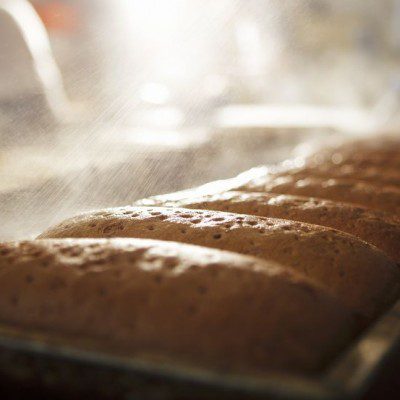Application
- A 100% RH reading means that at a given temperature, a given volume of moist air is saturated with water vapor so it can no longer hold any more water. It also means that the moist air holds the maximum possible number of water vapor molecules which creates the possibility for water vapor to condense if temperature decreases.
- Since the maximum amount of moisture that air can carry increases with increased temperature, it is important to specify air temperature whenever RH is expressed.2 Air and other gases can double the amount of water vapor they can hold with every 18°F (10°C) rise in temperature.
- Use a psychrometric chart to determine your Relative Humidity.
Relationship between relative humidity and water activity of food materials
Shelf-life and chemical stability (rate of deteriorative reactions) as well as microbial stability of bakery products are controlled by intrinsic (formulation) and extrinsic factors (processing parameters and environmental conditions to which the product is exposed during processing, distribution and storage).
Examples of intrinsic factors that can be controlled by selection of raw materials and ingredients:
- pH
- Water activity
- Enzymes
- Microorganisms and concentration of reactive compounds
Examples of extrinsic factors:
- Temperature during baking
- Air flow in the oven
- Heat flux that burners in an oven can deliver
- Relative humidity (during proofing and retarding)
- Light or radiation
- Pressure of gases (or vacuum) during mixing
- Mechanical stresses and strains during makeup
Water activity, aw, is defined as the ratio of the partial vapor pressure of water above a food sample(p)to the vapor pressure of pure water at the same temperature(po):3
![]()
It is determined using specialized instruments that measure the equilibrium relative humidity (ERH) of a food. The value of aw for a sample can therefore be determined from the equilibrium RH humidity (ERH, %) of air surrounding the sample in a sealed measurement chamber:
![]()
It is important to note that the use of relative humidity (RH) for determining aw is dependent on the substance measured being in equilibrium with the atmosphere in which RH measurement is taken. This equilibrium requires time to occur (food sample takes up/loses water from/to the surroundings until the moisture gradient between sample and air disappears) and can vary with the measurement method selected.
Relative humidity during final proofing
Proofers are designed to provide very humid conditions to boost yeast activity, keep dough moist and allow dough to leaven and expand very quickly. A normal bread dough proofer is operated at 95–110°F (35–43°C) with a RH of 80–85%. These conditions can be created by raising air humidity via injecting steam into fresh air passing through heating coils. Just for comparison, normal room conditions are 68–73°F (20–23°C) with a relative humidity of 50–55%.
Relative humidity during baking
Because the temperature in an oven is greater than the boiling point of water (212°F or 100°C at sea level) and far beyond the temperature range in which moist air can be modeled as a perfect gas, humidity in the baking chamber cannot be measured as RH.
The amount of moisture present in the oven baking chamber, as a function of the drying process and from the products of combustion, should be defined in terms of mass of moisture relative to the air present (e.g. grams water/grams air), or as dew point (the temperature at which moisture in the air will condense on a surface).4
References
- Singh, R.P., and Heldman, D.R. “Psychrometrics.” Introduction to Food Engineering, 5th edition, Academic Press, Elsevier Ltd., 2014, pp. 593–611.
- Gatley, D.P. “Relative Humidity.” Understanding Psychrometrics, 3rd edition, American Society of Heating, Refrigerating and Air-Conditioning Engineers, Inc., 2013, pp. 127–132.
- Campbell-Platt, G. “Food Chemistry.” Food Science and Technology, 2nd edition, John Wiley & Sons, Ltd., 2018, pp. 43–88.
- Manley, D. “Biscuit baking.” Manley’s Technology of Biscuits, Crackers and Cookies, 4th edition, Woodhead Publishing Limited, 2011, pp. 477–486.

